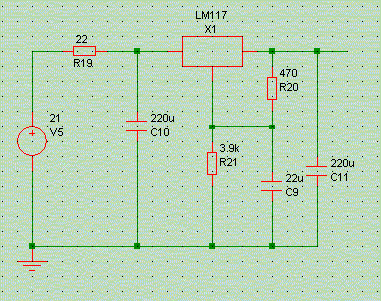

The above schematic comprises almost anything you can put around the ubiquitous LM317 positive 3-pin regulator (LM337 for negative voltages, 117 and 137 military versions). The basic circuit dispenses with the R19/C10 input filter, and the C9 adjustment pin bypass capacitor. The input filter is for ripple suppression only, so we'll ignore it for the time being. Let's start with a look at the LM317/337 as employed without adjustment capacitor, in which case it comes pretty close to those other 3-terminal stallwarts, the 78-series and 79-series of fixed voltage regulators.
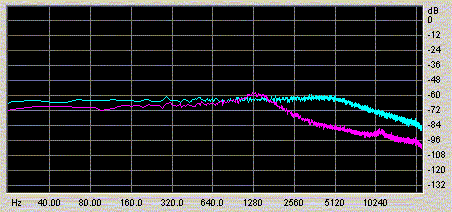
In the above plot the pink trace is the output noise spectrum of our 12V LM317 power supply, and the blue trace is that of the LM337 negative supply. On both rails a 220uF Rubycon ZL capacitor was used, a medium-quality elcap with an ESR of about 75 milli-Ohms. Both 317 and 337 were used without adjustment bypass cap.
What can we say but that output noise is fairly high, about 250 uV RMS over the 20kHz bandwidth,and perhaps more importantly, noise spectra differ markedly between both polarities. Coupling the sense amplifier to my Cyrus One integrated and listening in with AKG K-400 headphones revealed a steady loud roar, quite different in timbre between 317 and 337. All in all quite appaling, this.
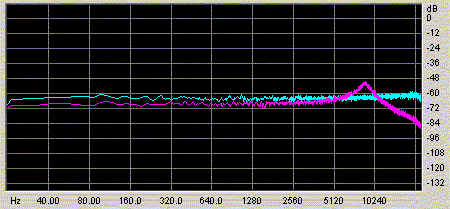
But things get even more interesting. See, the behaviour of an LM317 depends a lot on the capacitance at its output. Above plot was made with a 4.7uF Rubycon ZA cap (an ultra-low impedance component similar to Sanyo's OSCON, 540mOhms ESR) substituted for the 220uF one. This much lower value of capacitance reacts with the 317's rising output impedance and creates a pretty sharp noise peak at about 8kHz.
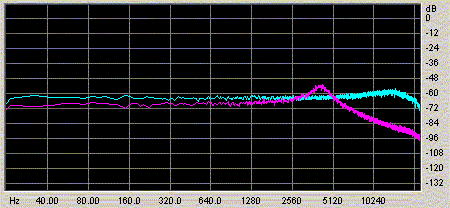
Replacing the 4.7uF C now with a 22uF one lowers the frequency and amplitude of the noise peak, though it still is there (it is even there with the 220uF cap, if you look closely). The negative-side LM337 has a similar tendency to peaking, but it is much less pronounced than with its sibling.
These peaks of noise are potentially harmful when feeding amplifier circuits with low power supply rejection, i.e. feedbackless transistor/FET circuits and even opamps when employed at high gain. Moreover the peaking nature of this phenomenon indicates problems with stability, which might even be worse news.
You won't read about this in these regulators' datasheets, but it has been documented in articles such as Erol Dietz' "Understanding and Reducing Noise Voltage on 3-Terminal Voltage Regulators", Electronic Design (issue unknown) , and Steven Sandler's "Spice Uncovers Regulator-Stability Problems", Personal Engineering, August 1998. From these you would also learn that an LM317's output inductance varies with its output current, and hence that the above noise peaking is load-variant to boot. Just what we needed: a signal-modulated noise generator!
Some manufacturers, notably LFD, are known to follow these types of regulators with severe RC low-pass filters. In one phonostage I saw 7812/7912s followed with 75 Ohms and 2200uF, if I remember correctly. This should take care of the noise, although at the expense of regulator output impedance.
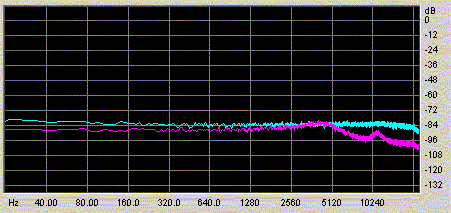
Let's put back the 220uF output capacitor, then, and bypass the adjustment pin, in our case with a 22uF ZL. And what happens? Noise is reduced tenfold with about 20dB. Much much better, although in the headphones these voltage rails still sound rather 'roary'.
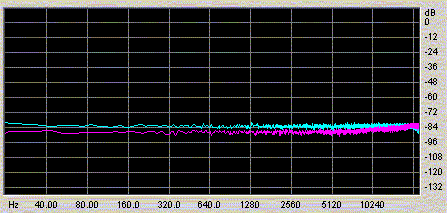
Would there still be noise peaking? Out again with the 220uF C, and in with the dreaded 4.7uF ZA. The result? See above: the peaking is all but gone, and moved up in frequency to beyond 20kHz. As an aside, our 317 now behaves almost the same as the 337.
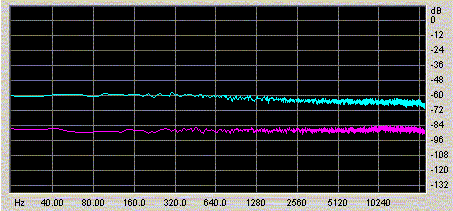
Finally then measurements from a particular case: both regulators have their adjustment pins bypassed, but there are no output caps present. The 317 retains its relatively low noise, but the 337 goes through the roof.
© Copyright 2004 Werner Ogiers for www.tnt-audio.com